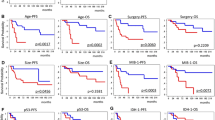Abstract
Loss of heterozygosity in the long arm of chromosome 10q is a frequent event in gliomas. It may involve the LGI1/epitempin gene, which is located in chromosomal region 10q23~24 and has been proposed to encode a tumor suppressor inactivated in the progression of brain tumors. Nevertheless, so far no data are available demonstrating that the reduced expression of the LGI1 transcript in high-grade astrocytic tumors indeed results in a decreased level of LGI1 protein in the tumor cells. Thus, the aim of the present study was to analyze the expression of the LGI1 protein in a series (ten of each) of pilocytic astrocytomas, astrocytomas [World Health Organization (WHO) grade II], anaplastic astrocytomas (WHO grade III), and glioblastoma multiforme (WHO grade IV). Immunohistochemistry demonstrated a strong expression of the LGI1 protein in normal brain tissue as well as in the majority of pilocytic astrocytomas and astrocytomas (WHO grade II). In anaplastic astrocytomas, the number of tumor cells expressing LGI1 decreased, while LGI1 expression was completely absent from the glioblastomas of this series. This highly significant reduction of LGI1 protein expression in the progression of astrocytic brain tumors lends further support to the hypothesized function of LGI1 as a type-II tumor suppressor gene in glioma pathogenesis.

Similar content being viewed by others
References
Chernova O, Cowell JK (1998) Molecular definition of chromosome translocations involving 10q24 and 19q13 in human malignant glioma cells. Cancer Genet Cytogenet 105:60–68
Chernova OB, Somerville RP, Cowell JK (1998) A novel gene, LGI1, from 10q24 is rearranged and downregulated in malignant brain tumors. Oncogene 17:2873–2881
Deckert-Schlüter M, Rang A, Wiestler OD (1998) Apoptosis and apoptosis-related gene products in primary non-Hodgkin's lymphoma of the central nervous system. Acta Neuropathol (Berl) 96:157–162
Fujisawa H, Reis RM, Nakamura M, Colella S, Yonekawa Y, Kleihues P, Ohgaki H (2000) Loss of heterozygosity on chromosome 10 is more extensive in primary (de novo) than in secondary glioblastomas. Lab Invest 80:65–72
Gu W, Brodtkorb E, Steinlein OK (2002) LGI1 is mutated in familial temporal lobe epilepsy characterized by aphasic seizures. Ann Neurol 52:364–367
Gu W, Wevers A, Schröder H, Grzeschik KH, Derst C, Brodtkorb E, de Vos R, Steinlein OK (2002) The LGI1 gene involved in lateral temporal lobe epilepsy belongs to a new subfamily of leucine-rich repeat proteins. FEBS Lett 519:71–76
Kalachikov S, Evgrafov O, Ross B, Winawer M, Barker-Cummings C, Martinelli Boneschi F, Choi C, Morozov P, Das K, Teplitskaya E, Yu A, Cayanis E, Penchaszadeh G, Kottmann AH, Pedley TA, Hauser WA, Ottman R, Gilliam TC (2002) Mutations in LGI1 cause autosomal-dominant partial epilepsy with auditory features. Nat Genet 30:335–341
Krex D, Hauses M, Appelt H, Mohr B, Ehninger G, Schackert HK, Schackert G (2002) Physical and functional characterization of the human LGI1 gene and its possible role in glioma development. Acta Neuropathol (Berl) 103:255–266
Morante-Redolat JM, Gorostidi-Pagola A, Piquer-Sirerol S, Saenz A, Poza JJ, Galan J, Gesk S, Sarafidou T, Mautner VF, Binelli S, Staub E, Hinzmann B, French L, Prud'homme JF, Passarelli D, Scannapieco P, Tassinari CA, Avanzini G, Marti-Masso JF, Kluwe L, Deloukas P, Moschonas NK, Michelucci R, Siebert R, Nobile C, Perez-Tur J, Lopez de Munain A (2002) Mutations in the LGI1/Epitempin gene on 10q24 cause autosomal dominant lateral temporal epilepsy. Hum Mol Genet 11:1119–1128
Somerville RP, Chernova O, Liu S, Shoshan Y, Cowell JK (2000) Identification of the promoter, genomic structure, and mouse ortholog of LGI1. Mamm Genome 11:622–627
Staub E, Perez-Tur J, Siebert R, Nobile C, Moschonas NK, Deloukas P, Hinzmann B (2002) The novel EPTP repeat defines a superfamily of proteins implicated in epileptic disorders. Trends Biochem Sci 27:441–444
Acknowledgements
The authors wish to thank Drs. M. Plomann and J.I. Martin-Subero for help with antibody purification and with statistical analyses as well as H.U. Klatt for photographic help. The studies of R.S. on tumor suppressor genes in 10q24 and LGI1 changes in neurological diseases are supported by the Deutsche Krebshilfe and the Hensel-Stiftung Kiel, respectively. The work of J.P-T. is supported by the Ministerio de Ciencia y Technologia (grant SAF 2002-00060). J.P-T. and R.S. are members of the European Collaborative Consortium on the study of ADLTE. R.B., from the Colentina Clinical Hospital, Department of Neurology, Bucharest is a fellow of the EURON Ph.D. program.
Author information
Authors and Affiliations
Corresponding author
Rights and permissions
About this article
Cite this article
Besleaga, R., Montesinos-Rongen, M., Perez-Tur, J. et al. Expression of the LGI1 gene product in astrocytic gliomas: downregulation with malignant progression. Virchows Arch 443, 561–564 (2003). https://doi.org/10.1007/s00428-003-0874-3
Received:
Accepted:
Published:
Issue Date:
DOI: https://doi.org/10.1007/s00428-003-0874-3




